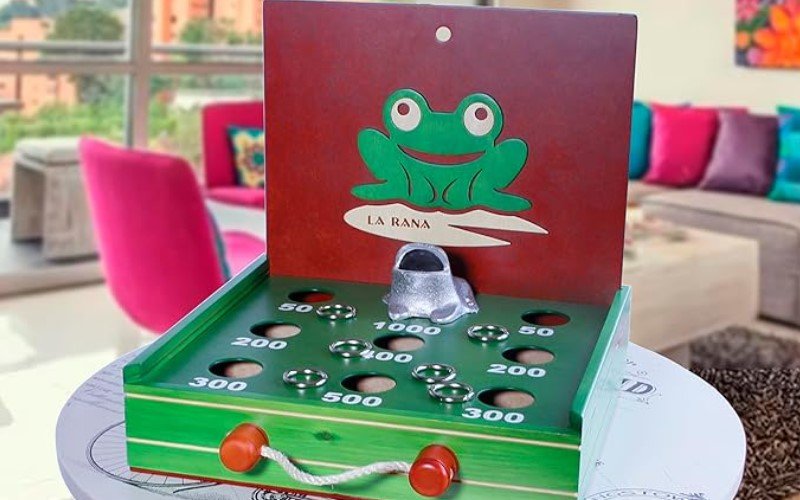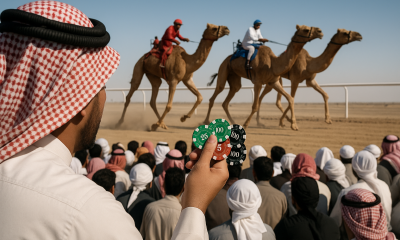around the world
The Game of Sapo: Peru’s Ancient Betting Game

Most tourists will remember it as the Frog Game in Peru, typically played in chicherías, picanterías or town plaza. Yet to locals, “Juego del Sapo” is more than just a pub game in Peru. It has stood the test of time, heralding from the ancient Incans to modern day Peru. Sapo is also quite well known in various European countries, where the game may be known as Sapo, Jogo de Sapo, Le Jeu de la Grenouille, or simply, Toad in the Hole.
Sapo is very much a social game, that brings together communities and adds some gambling element to create competition. Combining skill with fluke and luck, it is easy to understand the game’s great appeal. And beginners can learn how to play this game within a few seconds. And it is definitely a game you can practice, get better at, and stake real money bets on.
How is Sapo Played in Peru
The premise of Sapo is to throw coins, or Fichas, onto a table into designated holes. In the middle of the table, the most important hole is covered by a frog statue with an open mouth. And if you can land a ficha in the frog’s mouth, you can yell out “¡Sapo!”. The fichas can be coins, small discs, pucks, or even rings made of bronze. A minimum of 2 players are needed to play Sapo, and during a turn, each player will throw all their fichas onto the table one by one. When your turn is finished and you have thrown all your fichas, the next player goes.
You can either play the game to reach a specific score, or play for the highest score. Each hole has different scores, and there are tables that may have additional obstacles or barriers to make it more difficult. In most customs, you get 10 fichas to build your score. Though some games may have as little as 6, or as high as 12, it all depends on where you play, and how many people are playing. If your ficha enters the frog’s mouth, you get the max score.
This game is typically played on All Saints’ Day, though you will find it played all year round in Peru.

History of Sapo
According to ancient legend, the royal Inca king, the son of the Sun God, would travel to Lake Titicaca and throw gold pieces into the lake. These were caught by Sapos, or toads, which were believed to have magical powers. For every one piece that the toads caught in their mouth, the Inca King would be given a wish. And the toads or frogs would then turn into gold. The Inca King then built a golden statue of a great Sapo in the royal palace in Cusco.
The Incan Empire was the largest in the pre-contact era, spanning from the southernmost part of Colombia down to Chile, including Peru and Ecuador. In 1528, the Spanish invaders landed at the borders of the Inca Empire. From 1532 to 1572, the Spanish finally colonized the region, ending the Incan Empire.
The game of Sapo, however, didn’t disappear with the Incan Empire. Instead, the Spanish adopted and transformed the game. Instead of throwing gold pieces into a lake, they reimagined Sapo as a board game. Sapo tables and Sapo boxes were made, and became a popular game under Spanish conquest. So much so, that Sapo was even brought back to Spain. Though the game did not use gold or silver, so it didn’t catch on with the Spanish royalty.
Modern Sapo
Sapo didn’t undergo many more transformations. The modern game is quite similar to the Sapo played under the Spanish Conquest of Peru. It features a grand wooden table, with 25 holes and a gold frog statue in the middle. It can be played as a drinking game, between friends, or for money. And modern variants can have different obstacles and elements to make the game harder. You can even find portable Sapo boards, built by local artisans. Though Sapo is not only enjoyed in Peru. It is quite popular among the old Incan territories, and there are versions of Sapo all across South America.
Variations of Sapo Around the World
Sapo didn’t stop at Spain when it was brought back from the New World. It travelled to France, England, Portugal, and various other European countries through merchants. In the British territories, this game became popularly known as Toad in the Hole. In France, it was known as Le Jeu de la Grenouille, involving nothing more than a barrel or cask into which the tokens must be thrown. Some versions didn’t feature the toad or frog at all. But there were also some variants that had boards with holes, and painted-on toads.

Betting Traditions and Gambling Element
At its heart, Sapo was intended to be a social game. It is not really meant to be played by 1 person, or against the “house”. You could play Sapo and bet on beers, (chichas), or for favours, coins, and so on. It is quite a big part of social gatherings and festivals or tournaments, where you can find Sapo being played for larger stakes.
Sapo is not designed to be a betting game. It is perhaps most similar to darts. But, just like darts, the nature of Sapo lends to many different types of wagering possibilities and habits. You can bet on which player will score highest, or create your own side bets. Such as who will score a frog shot, or how many frog shots you can score.
But then you aren’t just betting on something that is random and down to luck. Luck is needed to pull off a frog shot or get the fichas into specific holes to obtain a certain score. But you can also practise the game and become more skilled.
Element of Skill and Addictive Traits of the Game
Experienced players will have better coordination and muscle memory to help them gain an edge over new players. This adds to the charm of the game, as if you have a good ability to guide the fichas into the holes, you can win more and go up against the better players. Though it also makes Sapo quite an addictive games.
You can get addicted to this game, especially when the friendly competition evolves into something a little more significant. Betting on who will get the next round can escalate into real money wagers, and even into high stakes showdowns where players may stake thousands of Sols. Skilled players may experience a little gambler’s conceit, believing they can outskill their opponents or score more consistently.
But it doesn’t take away the fact that anything can happen. A skilled player may experience fatigue, or building pressure, or just miscalculate their throw. And if the inexperienced player has a good streak of luck, they may just beat them. The game is easy to learn, and even someone who has never played anything similar may get lucky and hit a few frog shots in their first few goes.
It is very difficult to judge what will happen, and for this reason, you don’t really get “house odds”, or establishments taking bets on Sapo. Because there is no way a sportsbook can calculate the odds to give itself an edge. Just like you don’t really find sportsbooks taking bets on “rock, paper, scissors”, or other very fickle games.

Why Casinos Do Not Offer Sapo
Sapo cannot really be replicated at a casino. Anything that is really similar to Sapo at all may be found at arcades or amusement parks. Such as carnival basketball hoops, rifle ranges, skee ball, or whack-a-mole. Perhaps the casino game that is closest to Sapo is craps. In that you have to throw dice and bet on combinations of score. This game also has a perceived skill element to it, but it is not as pronounced as Sapo. Because you can’t really practice and learn how to influence the roll of a dice.
Roulette also, in that regard, could be considered a casino alternative to Sapo. But instead of you throwing fichas onto a board, you are betting on where the ball will land on a roulette wheel. Casino games need to be designed in a way that the outcomes are more random, and not as biased as games like Sapo. A casino couldn’t offer players payouts on a Sapo board. Just think about it. How would the casino offer a payout to players if they don’t know whether the player is “skilled” or not.
And you can’t offer one paytable structure to one player, and another to someone else. If the payouts are gauged for a skilled person, you may get really short odds on scoring a frog shot, or obtaining a relatively average score.
Casinos can only offer games where the results are more random, and using probability, they can determine the payouts. Even in “skill based” games such as poker, video poker or blackjack, the games are designed to give the house an edge. As you cannot really predict the draw of a card. Even if you are counting cards or are using a mathematically optimised strategy.
The Lasting Impact of Sapo
Sapo is not a casino game, and shouldn’t be either. It is a cherished pastime and social activity in Peru. Possibly, you can find variants of this game at theme parks or gaming arcades. Whether you play Sapo for money or just for a little friendly competition, it is a game for all to enjoy.
If you are travelling through Peru, it is highly worth checking into a chichería and look for a Sapo board. It is a taste of something cultural and authentic, and unexpectedly quite addictive. Just be careful not to get too carried away with your gaming, and don’t start increasing bets or playing double or nothing. Like any other gambling venture, skill based or not, you should always play responsibly and never bet with more money than you can afford to lose.














